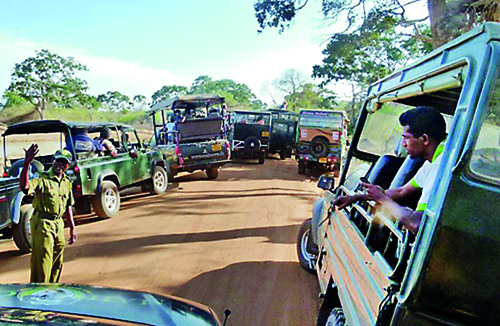News
610 jeeps, 60 trackers – sum of one day’s tragedy for hunted Yala animals
Despite recording increased tourist traffic through the years Yala National Park still struggles to meet the demand for guides who accompany visitors to the park.
During December, a peak period, visitors were allowed to enter the park without a tracker or a tracker, the only persons authorised to step out of vehicle when inside the park grounds.
According to the Department of Wildlife, the park needs at least 200 trackers to meet the demand during the peak periods. Visitor numbers usually peak during the school holidays and long public holiday periods.
The park currently has only 100 reackers, the department says. Most are volunteers who are paid Rs. 500 a day as an allowance.
This number is disputed by the Jeep Owners’ Association secretary, Tharindu Jayasinghe, who said there were only 12 permanent guides attached to the Yala sanctuary, while about 50 others worked on a voluntary basis.
The shortage of trackers has given rise to problems such as visitors alighting from vehicles while inside the park, and speeding, resulting in hit-and-run accidents suffered by animals inside the sanctuary. Several leopards have been run over and killed. These problems have been compounding over the years with the department taking little action.
On December 29, Yala recorded the highest visitor income in its entire history as a national park, collecting Rs. 3,433,920 with 610 jeeps entering the park. A total of 3302 tourists visited the park.
There were two accidents inside the park last week. One person was injured and hospitalised in one incident. In the other a modified Mahindra maxi truck which toppled, had to be towed out of the park.
“The reason for most of these accidents is the indiscipline of the drivers,” Mr. Jayasinghe said.
“Most often there are no guides in the vehicles and there would be no control exerted on the speed of the vehicle, resulting in accidents and other issues such as roadkill.” He said that in the absence of trained trackers there was no control on visitors’ behaviour, and visitors often – and sometimes deliberately – disturbed the animals.
“Often when one jeep spots a leopard, the star animal in the park, the drivers call others to inform them and the vehicles speeding towards the scene can cause harm,” he said adding that the association’s continued pleas to issue a licence for guides had fallen on deaf years.
Wildlife enthusiast Jagath Gunawardana, agrees adding that the vehicles rush in and block the animals from all sides, causing stress to the unfortunate creatures.
“There may be behavioural changes in the animals due to these issues. We’ve noted that the leopards come to the roadsides often now to feed on the roadkill of the jeeps, and this again poses a danger to the animal,” he said.
While he says it would be difficult to restrict the number of visits, Mr. Gunawardana proposes that there should be strict control and discipline exercised inside the parks.
“To do this we need guides who can go with each visitor group,” he said. “Strict action should be taken against offenders.”
Further he welcomed the move to close the park to the public during September, the drought period in the area.
“The animals are stressed during the time and this may alter their behaviour, increasing their vulnerability,” he said, noting that the action has received criticism in some quarters. Mr Gunawardana proposes closing the park at least once a week to reduce stress to the animals.
More trackers on the way says dept
The Department of Wildlife Conservation is to enlist the services of 100 more volunteer trackers to cater to growing demand at Yala National Park.
“Yala park needs at least 200 trackers to meet the demand during the peek seasons. We have about 100 now including all the volunteer trackers,” the department’s Director General H. D. Ratnayake said.
Mr. Ratnayake said that visitors to the park had doubled over the past two years due to publicity given to the park both nationally and internationally.
“This is a good trend. Foreigners who are nature enthusiasts are increasingly attracted to this country. In all of Asia we have one the best potential to make the country a wildlife tourist destination,” he said.
“We are making plans to improve this now.”
Mr Ratnayake said the department had already opened Zone 2 and Zone 3 at Yala to accommodate all the visitors.
“We plan to open up Zone 4 as well to disperse the traffic inside the park,” he said, adding that the area needed to be developed before doing so.
“The zone does not have road access yet. We need to develop that. This is good to ensure security as we are able to monitor better and chances of poaching would be reduced,” he said.

